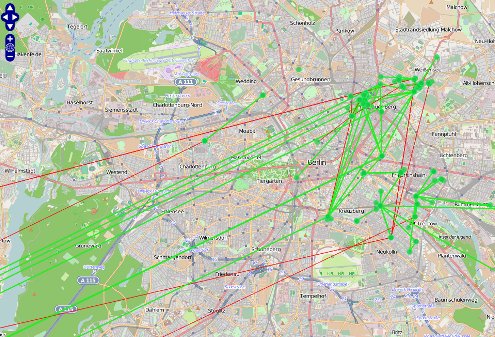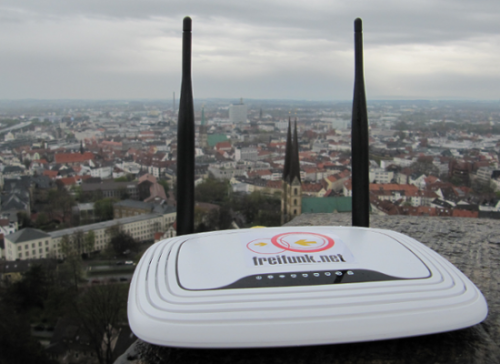Wie Juergen Neumann auf der Berliner Mailingliste der Freifunk-Community angekuendigt hat, stehen nach 3 Jahren Entwicklungsarbeit durch das OpenWRT-Team die ersten “Freifunk-Freedom-Fighter-Boxen” bereit.
Hintergrund: Vor drei Jahren haben wir (freifunk.net und OpenWRT) über den Foerderverein Freie Netzwerke e.V. 7 Paletten mit je 80 Routern vom Typ WAV-281 von AirTies geschenkt bekommen. Bedingung für die Nutzung oder Weitergabe der Geräte war und ist, dass sie alle mit einer neuen Firmware geflasht werden müssen, und dass wir etwas Werbung für AirTies machen sollen.
Die Router wurden damals von der Firma ZAPF Umzüge kostenlos für uns in Frankfurt/Main abgeholt und seit dem in einem Container hier in Berlin gelagert. Zirka 100 Geräte sind bereits an verschiedene Leute, vor allem aus der OpenWRT-Community, verteilt worden.
Seit dem letzten WCW gibt es nun endlich eine funktionierende OpenWRT-Firmware für die Router. Über Mirko haben wir außerdem von einem Provider in Schweden 100 VPN-Tunnel für eine Campagne gegen die Störerhaftung und für anonymen Internet-Zugang gesponsort bekommen. Mirko hat hierfür eine spezielle, vorkonfigurierte FFF-Firmware entwickelt.
In den kommenden Wochen wollen wir nun 100 FFF-Boxen (vor allem) in Kreuzberg und Friedrichshain verteilen. Die Boxen arbeiten ausschließlich im Access-Point Modus (mixed mode kann der Chip leider nicht) und bieten ein offenes WLAN an. Beim browsen erscheint folgende Splashpage: http://anon.freifunk.net .
Der gesamte Datenverkehr aus dem offenen WLAN wird per VPN nach Schweden zu IPREDATOR getunnelt und purzelt erst dort mit einer IP Adresse des Providers ins Netz. WLAN-Surfer und DSL-Inhaber bleiben somit anonym. Zielgruppe der Aktion sind vor allem Projekte, Kneipen und Cafés, die seit der Verwirrung durch die Störerhaftung i.d.R. nur noch verschlüsselte WLAN-Netze anbieten. Mit der Aktion wollen wir ein Zeichen gegen die Störerhaftung setzen und uns für offene und anonyme Internet-Zugänge engagieren. Die Bandbreite ins Internet ist geshaped, so dass nur ein Teil der DSL-Bandbreite für das WLAN genutzt wird. Der Router wird einfach per LAN-Kabel an den vorhandenen DSL-Router angeschlossen und baut dann automatisch einen VPN-Tunnel über das Internet auf.
Wenn ihr Kontakte zu Projekten, Cafés und Kneipen habt, dann wäre es prima, wenn ihr uns bei der Verteilung der Router unterstützen würdet. Alle Orte mit möglichst viel Publikumsverkehr sind interessant. Wir möchten uns gerne vor allem auf F’hain (Boxi) und Kreuzberg (Kotti) konzentrieren, um eine gewisse Dichte zu erzielen. Aber natürlich kommen auch Projekte, Cafés und Kneipen in anderen Stadtteilen in Frage, die besonders geeignet erscheinen, falls ihr da Kontakte haben solltet.
Einzige Bedingung ist, dass die Router öffentlich erreichbar sind, sofort in Betrieb genommen und zuverlässig auch längerfristig im Rahmen der Campagne genutzt werden.
Warum das Ganze?
Mit der Aktion wollen wir ein Zeichen gegen die Störerhaftung setzen und uns für offene und anonyme Internet-Zugänge engagieren.
Interessierte können sich an info@freifunk.net wenden.
Links:
- http://freifunkstattangst.de
- http://freifunkstattangst.de/2012/06/14/aktion-gegen-storerhaftung-anonym-im-wlan-an-offentlichen-platzen-mit-freifunk/
[via Juergen Neumann]


